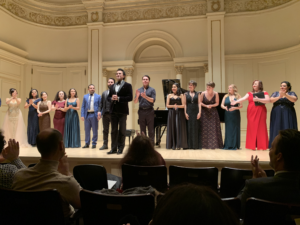
Carnegie Hall 2023 Review: Vincerò Academy Young Artist Gala
By Chris RuelA concert featuring young artists who have just completed a week of masterclasses is always a treat. The energy and enthusiasm of these vocalists as they sing their hearts out in front of a captive audience is inspiring.
At the Weill Recital Hall at Carnegie Hall on January 19, 2023, the Vincerò Academy’s young artists took the stage to perform their chosen repertoire. Artistic Director Abdiel Vázquez allowed the singers to perform any aria they desired. Though heavy on Mozart, the evening served plenty of operatic fare, from Monteverdi to Leoncavallo and Puccini.
A joy to watch, Artistic Director Abdiel Vázquez accompanied the young vocalists throughout the entire concert. His skill and passion for the music showed as he played nearly 30 numbers without a break. He was a masterful pianist and a charming and humorous host, relishing the opportunity to work with and present these talented artists.
The Vincerò Academy singers formed a diverse group, hailing from all corners of the globe, but with a strong representation from Latin American countries such as Mexico, Guatemala, and Peru. The concert featured 19 vocalists, including 12 sopranos, three mezzo-sopranos, and four bass-baritones. Such galas are an excellent opportunity to listen to various voice types, timbres, and ranges all in one place and are a feast for the ears.
Overall, the vocalists presented an outstanding evening of music. They worked hard, and each put their hearts into their performances; nothing could be more evident. Their dedication and passion for the art form, inspiring to see, undoubtedly grew and developed under the direction of Vázquez and the Vincerò Academy. It’s important to note that the Academy is online, so all the artists met their colleagues in person for the first time when they arrived in New York. The duets, and large ensemble pieces, the vocalists hashed out virtually.
Sopranos Alejandra Toledo (Mexico); Athena Christine Palombi (USA); Caroline Morales (Peru); Daniela Yurrita (Guatemala); Diana Monacelli (USA); Leslie Gonzàlez (Guatemala); Mariana Echeverría (Mexico); Quirina Lechmann (Switzerland); Stephanie Kim (Korea-Canada); and Taylor Gonzaga (USA) wowed with their unique voices and techniques.
Mezzos included Kelly O’Shea (USA) and Madeleine Gutiérrez (Peru), both able to navigate the lowest edges of their ranges.
The bass-baritones on the program, Antonio Azpiri (Mexico); Hongyu Chen (China); Enes Pektas (Turkey); and Victor Rodrigo Pérez, revealed low voices aren’t all the same, and each brings something to the table.
Mozart, Mozart, Mozart
The program opened with seven arias from “The Marriage of Figaro”: “Cinque, dieci;” “Bravo!… Se vuol ballare;” “Via resti, servita;” “Porgi Amor;” “Hai già vinta la causa;” “Sull’ aria;” and “Giunse al fin il momento… Deh, vieni.”
When Enes Pektas took the stage to sing “Hai già vinta la causa,” His voice, a booming, theater-filling sound, commanded attention from the moment he began singing.
Even more impressive, the confidence and ease with which he sang gave the impression that Pektas was at home on stage. He sang and moved with intention, his unique instrument on full display.
“Sull’ aria,” sung by Alejandra Toledo and Athena Christine Palombi, was another delight within “The Marriage of Figaro” sequence. The two singers took on the roles of Susanna and the Contessa and did it well.
Smooth as silk, with gorgeous lyricism, Toledo’s singing came across crystal clear with a light touch, well suited to the role of Susanna. Athena Christine Palombi, equally impressive, shimmered with a voice of refined silver.
The chemistry between the two brought out the best in the other.
Stephanie Kim also stood out during the Mozart portion of the concert. She performed the role of Ilia, singing “Padre, germani, addio” from “Idomeneo.” Precise and sharp, Kim’s coloratura never muddied during her dramatic phrasing.
Standout
Emma Robertson, the audience’s favorite soprano of the night, sang “Quanto amore” from Donizetti’s “L’elisir d’amore” and “Quel guardo il cavalier” from “Don Pasquale” and she slew. Her performance captivated the audience and she had an absolute blast on stage.
While other singers added some stage movement, hers reached another level, using comic expressions and gestures that gave the audience an understanding of the character.
The soprano range is outstanding, and she is gifted as a stage performer. She was a natural entertainer, and the audience took notice, giving her loud and extended applause.
The Mezzos Get the Spotlight
Kelly O’Shea, a striking mezzo, joined Stephanie Kim to sing the well-known (and therefore dangerous) “Dôme épais le jasmin,” from Delibes “Lakmé” The danger is that most everyone has heard the tune at some point, so if the vocalists are not quite in tune or the timing is problematic, the untrained ear will notice.
The duo sang with precision, confidence, effortless harmonies, and a flowing melody that charmed the audience and left them wanting more.
After her duet with Kim, O’Shea gave a solo performance of “Va! Laisse Couler mes larmes” from Massenet’s “Werther.” She fired up those in the seats with unleashed opening notes that made you sit up straight.
O’Shea’s voice is a force. Her expansive vocal range, commanding presence, and navigation through the low notes added a layer of drama to her performance.
Madeleine Gutiérrez took an aria from the sporadically staged “Adriana Lecouvreur” by Cilea. Gutiérrez gave a strong performance of “Acerba voluttá.” With her impressive range and vibrancy, she possessed the amount of vocal heft the aria required. She sang with a sense of drama fitting for the role, and her dynamic delivery impressed.
Verdi & Puccini Favorites
Moving into the Verdi repertoire, Alejandra Toledo sang Gilda’s aria, “Caro nome,” from “Rigoletto.” Toledo’s top notes rang with stunning squillo. Like a delicate butterfly, fluttering through the notes with ease and grace, she fit the aria to a T.
Taylor Gonzaga gave a notable rendition of “Quando m’en vo (Musetta’s Waltz)” from “La Bohème.” Her rich, natural-sounding vibrato added a lovely touch to her singing. Exciting top notes rang in the ears—always a pleasing sensation.
Leslie González, sang the classic crowd-pleaser “Vissi d’arte” from Puccini’s “Tosca” . It was a convincing rendition that met the demands of the aria, depth, emotion, and a wide range of dynamics, all of which she met brilliantly.
Baritones Rule
Hongyu Chen showcased his vocal abilities with “Avant de quitter ces lieux,” sung by Valentin in Gounod’s “Faust.” He also portrayed Figaro in “The Barber of Seville,” where his firm tone blended well with Quirina Lechmann’s. Later in the evening, the soprano gave a fine performance of “Der Hölle Rache,” from Mozart’s “The Magic Flute.” Lechmann navigated the runs, jumps, and tippy-top notes well with sparkling coloratura.
Mozart served as the finale of the evening as the ensemble performed the last scene of “Don Giovanni,” an extraordinary way to showcase the talents of the entire ensemble.
Sometimes, when you listen to a baritone, you might think, “Wow, they would make a great Leporello or Don Giovanni.” Likewise, when you discover a young bass well-suited to sing the Commendatore. It was a treat to hear a talented group of baritones perform the finale. It was well cast.
Antonio Azpiri, in particular, stood out for his versatility, Figaro arias in “The Marriage of Figaro,” sequence, Dulcamara in “L’elisir d’amore,” and in the finale, “Don Giovanni’s” Leporello. His knack for bringing something different to each character showed his range as an artist and made each piece distinct and gratifying.
Azpiri displayed a robust and plush baritone with a rich low end, and he gave an animated performance, embodying the character’s comical nature. He portrayed Leporello’s cowering, pleading, and cajoling of his master, Don Giovanni, with fine comedic timing, which felt natural and well-honed.
As the Don, Enes Pektas shone. He embodied the stubborn and rapacious nature of the aristocrat. His boldness in the face of the Commendatore and nonchalance regarding his eternity rivaled any well-played Don.
As one of the more terrifying characters in Mozart’s operas, the supernatural statue of the Commendatore serves up a cold dish of revenge. Victor Rodrigo Pérez, who earlier in the night portrayed the swaggering Escamillo in “Carmen,” appeared more assured in this character, and his deep bass voice added the otherworldly element to the performance. The rest of the ensemble gathered behind the characters and served as the demonic chorus that sounded more heavenly than hellish.
Wrapping it Up
Three singers not previously mentioned, Mariana Echeverría, Diana Monacelli, and Daniela Yurrita, all performed with verve and energy. Echeverría sang “Silvio, a quest’ora” from “Pagliacci” and delivered a delicate portrayal of Nedda opposite Chen. They were perfectly paired, and their voices filled the auditorium beautifully. Monacelli selected an aria from “Les pêcheurs de perles,” “Comme autrefois.” Her voice has a wonderful ping, and when she lets loose during a forte passage, look out! And Daniela Yurrita went with an aria from “Falstaff,” “Sul fil d’un soffio etesio.” She effortlessly floated notes and had a keen sense of humor that was well suited to the performance. All three singers added their own unique flair to the performance.
Every one of the 19 young artists sang splendidly and have much to be proud of in their Carnegie Hall debuts. The tired joke about a lost gentleman asking a violinist for directions is a truism: “How do I get to Carnegie Hall?” “Practice, practice, practice.” While practicing never stops, these vocalists put in the requisite amount to sing at the prestigious venue and bowled over the audience with their art.



